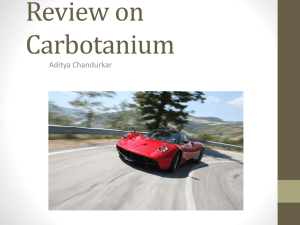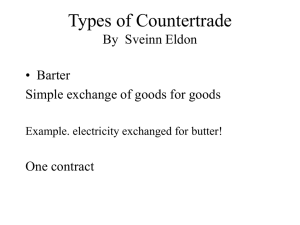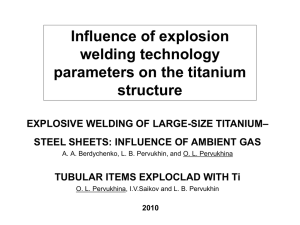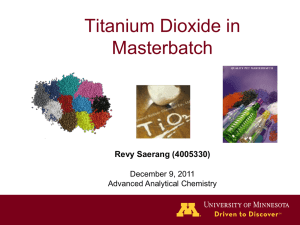SILIKÓNOVÉ ODTLAČKOVÉ MATERIÁLY (indikácie a použitie)
advertisement
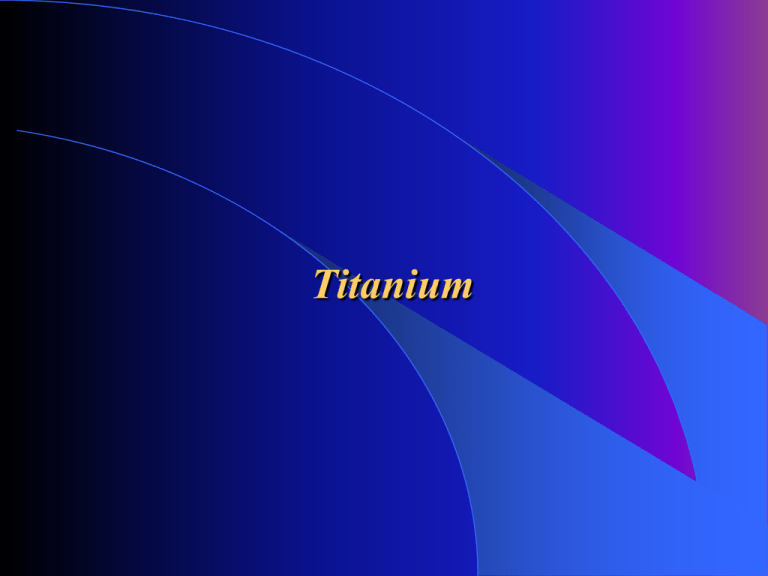
Titanium Introduction: - titanium is very good biocompatible material - it has a exeptional resistance before corrosion - it can be as a bioactive material, which can make adhesion to the vital tissue - even though it was applyed in dental practice as a last metal material Introduction – titanium and its alloys: - in the nature is titanium as binary alloys, as a oxid TiO2 - it discovered in 1789 in department of Cornwallu - at 1795 y. Mr. Klaproth detected, that it isi oxid unknown origin and he termed as a titanium - the rich europen deposits of titanium are in the Norway, Finland and in Russia - at 1822y. – was first isolated pure titanium , but in very little rate. It was enough for laboratory research. - at 1910y. – at first was isolated a lot of pure titanium Mr. Hunter, it was reaction between TiO2 and natrium Introduction – titanium and its alloys: - at 1932y. – it was begin of industrial production of titanium ( chemical reaction between TiO2 and calcium) - from this metal it maked wires, plates and zo získaného kovu sa sformovali tyče, drôty a plech - other technology used for industrial production, chemical reaction between TiO2 and magnesium - with this technology was made a lot of tons of pure titanium. It was in America, Japan and in Russia. Chemickal characteristic: - Titanium is alotropic metal (as a solid state has in two phases with unequal atomic lattice) - from the temperature 882°C is as a .............. Atomic lattice , which is not so stable , as a cubic atomic lattice - if the temperature is less than 882°C, titanium has cubic atomic lattice - for practice it means, that by the temperature diverse between cooling and melting create changes between these two internal structure - by the very quick cooling, the number of atoms is decreased and it results to the depression of mechanical resistance Chemical properties – pure titanium: - this metal has a strong potential to release the hydrogen - it results to the: - volume expansion of titanium maximally about 15 % - titanium obtained light color - metalic brightnees Chemical charakteristic – pure titanium: - the atoms of oxygen and nitrogen can very quick to diffuse into the atomic lattice and so incresed melting temperature - it means, that by heating create: - oxidation on surface layer - dissolution of oxygen and nitrogen in metal - the very hard and think layer on surface, which is protection of titanium before oxidation. This layer must be remove before processing - others elements, as a niob, tantal, alluminium, tin and zircon change the mechanical properties by the changes into the atomic lattice Physical properties: - titanium is the metal steel color with high brightness - difference from steel is in the weight. It is result from unequal density - the density of pure titanium is about 4,51 g/cm3 , and Ti – alloys is 4,40 – 4,80 g/cm3 . - in equation with cobalt alloys, which have density about 8,2 g/cm3 , the weight of the metal titanium cast is less about 43% than weight of similar cobalt cast ( according to large and shape) - titanium has worse termic conduction than cobalt alloys titán Mechanical properties: - the mechanical properties is good, but titanium is more breakable than cobalt alloys, it has narrower flexibility - for the modification of mechanical properties is added to the titanium others elements, as a oxygen and ferrrum - according to content of oxygen and ferumm, can be the titanium alloys divided at four group( T1- T4)( similar distribution as a gold alloys) ; from soft to hard alloys Corrosion of titanium: - pure titanium is very resistant metal - pure titanium can be enough stable in water and acid solution, - it is resistant to action of sulphur compounds - but fluoride compounds can change the surface of titanium and so support corrosion - similar effect have fluoride toothpaste with high content of fluoride ( more than 2000 ppm. They are the pastes for caries prevention , as Elmex gel, fluid or others solution for tooth protect before caries) - fluorides from solutions remove the passive layer from surface and so enable the absorbtion hydrogen and so participate on oxidatation and corrosion surface layer of titanium Melting of titanium: - the melting of titanium is by the mercury arc in vacuum - intense cooling creates strong crust on the inside surface of special box - this crust can isolate melting titanium from the elements of box - this metod names as a „skull melting“. Melting of titanium: - other type of melting titanium is during the induction current, the melting titanium is absorbed by the special ceramic box, which is indifferent according to composition of ceramic box - the ceramic crucible is to expensive and it can be used only once kelímok je však drahý a vhodný len na jedno použitie - this melting is in the vacuum with special inert gas, argon (colorless and odorless gas) - cooling of melting titanium is in vacuum too Soldering: - soldering of titanium parts is by the welding - according to very strong chemical reaction of titanium by the temperature above than 500°C, must be soldering very quick and with high thermal energy - this condition satisfy the mercury arc, plasma, laser ray and electron stream - laser ray is the best for soldering of titanium parts - laser is device which can generate the monochromatic ray with high density of electrons and from it result the high thermic energy - it can function continuously Soldering: -other type of soldering is by the solders - for soldering of titanium parts can be used the solders on argentum or palladium base - the cooling of soldering place must be during the protect atmosphere, in vacuum - the soldering space is the site with reduced resistence before corrosion Biocompatibility: - titanium can be good biocompatible metal and bioactive metal - as a bioactive metal is participate the ions OH-, which can react with macromolecules of vital tissue and so produce biofilm - biocompatibility is compared with biocompatibility of gold alloys, although the titanium belong to the general metal alloys - it can make the active connection with vital tissue - although the price of pure titanium is narrower than the price of gold alloys, the technology of producing titanium is very expensive Biocompatibility: - the resistance before corrosion is very strong, according to good passive layer - for elimination of cytotoxic elements is enough few milliseconds and the thickness of passive layer is only few nanometers - titanium in dental practice was begin use at 60-y. of 20.century - it was good reconstruction for very mechanical shirt sleeved, it was for implants of large joints - in equation with cobalt alloys the titanium alloys have better resistnace before corrosion , better biocompatibility and active bioadhesion Conclusion: - in dental practice is used the titanium as pure metal - from titanium are made implants, crowns, metal construction for fixed bridge, metal framwork for sceletal RPD, clasps system and so on.... - in combination with ceramic, have to be use the special type of ceramic ( it is zircon oxid ceramic, aluminium oxide ), because these types of ceramics are indiferent to the titanium and dont make the changes in atomic structure - the titanium is distribute from name as a Tritan, Rematitan ( as 6g rollers) Pre prax: END.


